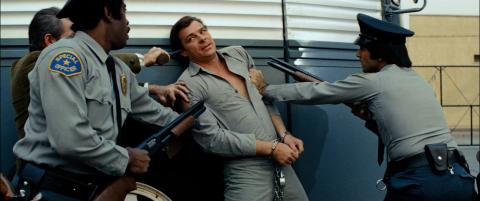ASSAULT ON PRECINCT 13: High Tension on a Low Budget in John Carpenter’s Urban Western

ASSAULT ON PRECINCT 13
These notes on John Carpenter's Assault on Precinct 13 were written by Lance St. Laurent, PhD candidate in UW Madison’s Department of Communication Arts. A new 4K DCP restoration of Assault from the American Genre Film Archice will screen on Saturday, February 23 at 7 p.m. The screening takes place at 4070 Vilas Hall, 821 University Avenue. Admission is free!
By Lance St. Laurent
With apologies to his debut film Dark Star (1974), it’s really John Carpenter’s follow-up (on which he served as director, writer, editor and composer), the ruthlessly entertaining Assault on Precinct 13 (1976), that we really begin to see Carpenter’s bona fides as a genre auteur and a classical stylist take shape. If you want to get extremely specific, one might go as far as to say you can pinpoint the exact moment, roughly thirty minutes into Assault, when John Carpenter starts etching his name into genre history. It’s a moment so dramatic and so self-assured in its wanton cruelty that the entire movie changes instantly around it. I’ll spare the details for those unfamiliar, but keep an eye out for an adorable little girl and an ice cream truck, and leave your good taste at the door.
Inspired by western classic Rio Bravo—Carpenter’s editorial pseudonym, John T. Chance, is even named after John Wayne’s character from that film—and the low-budget achievements of George A. Romero’s Night of the Living Dead, Assault on Precinct 13 is a classic siege scenario in the key of 1970s gang warfare, made on a budget of only $100,000. After a cold open depicting a street gang being ambushed and gunned down by a squad of heavily-armed LAPD officers, the living leaders of the gang swear a blood oath for revenge. Unbeknownst to either the gang or the poor souls trapped inside, however, is the fact that the gang’s attack takes place on the last night of duty for the decommissioned Precinct 13, leaving only a skeleton crew of officers, secretaries, and one in-transit prisoner to defend against the invading force.
Much like Romero’s Living Dead, the leader of this ragtag group of defenders is a black man, Lt. Ethan Bishop, played with uncommon gravitas in one of the only leading roles from character actor Austin Stoker. Despite this being uncommon casting for the period, Bishop’s race—like Duane Jones’ protagonist in Romero’s film—is largely unremarked upon and incidental to the story, instead enriching the subtextual character dynamics undergirding the film. His counterpoint is the exquisitely (and mysteriously) named Napoleon Wilson, played with a laconic, devil-may-care attitude by Darwin Joston. A prisoner on his way to death row who proves to be a cool head under pressure, Wilson is a source of some of the film’s best one-liners (“In my situation, days are like women - each one's so damn precious, but they all end up leaving you”).
Assault is a narratively stripped back sort of affair, limited locations and only a few major characters, but the dynamic between Bishop and Joston grounds the film’s drama and makes for a compelling pairing built on burgeoning respect instead of the macho posturing that defined so many later action films. This interracial dynamic is mirrored by the invading gang, a curiously diverse horde of black, white, and latino criminals brought together by a shared lust for violence and revenge. In the world of Assault on Precinct 13, violence may beget more violence, but it also serves as a unifying catalyst for breaking down existing social barriers, albeit in the names of vengeance and survival.
As with any John Carpenter film, though, the real star is the director himself. Assault is only Carpenter’s second feature film, and his first shot in CinemaScope, the aspect ratio (2.35.1) he would make his trademark. Working with cinematographer Douglas Knapp (who also shot Dark Star), Carpenter’s wide compositions and roving camera render the enclosed space of the besieged precinct as a place where death from outside can strike at any moment and tensions inside are slowly building to a boil. All of the skills Carpenter would bring to films like Halloween (1978) and The Thing (1982) are in their earliest bloom here, and the results, such as in the film’s sound design, are thrilling. The gang uses silenced rifles fired from a great distance to dispatch their prey, and the resulting attack first resembles less an explosive siege than the silent hand of death itself, reaching out to snatch life away from those unlucky enough to poke out their heads.
Throughout his career, John Carpenter has repeatedly shown himself to be a genre auteur whose technical craft is only matched by his keen sense of history. With Assault on Precinct 13, he placed himself in a long lineage of filmmakers who have reworked familiar genres over and over armed with little more than a barebones budget and a boundless sense of ingenuity. Filmmakers like Howard Hawks, Anthony Mann, Budd Boetticher, and Don Siegel—whose Riot in Cell Block 11 gets a tip of the cap from Carpenter’s own pulpy title—set the template, but it was filmmakers of the 1970s and 80s like Walter Hill, Tobe Hooper, and Brian De Palma who carried on this tradition of genre craftsmanship on the cheap. Among his peers, John Carpenter is among the most illustrious and the most multifaceted, far more varied than his “Master of Horror” moniker might suggest. His stylistic elegance and elemental storytelling prowess were almost unmatched in his prime, and he has become a titanic influence for generations of genre filmmakers since, even as he himself has receded into a comfortable retirement. For fans of Carpenter, Assault on Precinct 13 should be an essential text: a training ground for a master in the making and a captivating exercise in squeezing out the most bang for the fewest bucks.
